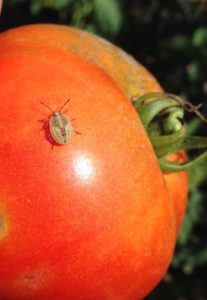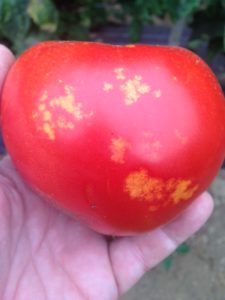NOTE: Cucurbit downy mildew (CDM) was detected on cucumbers at the Snyder Research and Extension Farm in Hunterdon County on Wednesday 07/07/21. No other cucurbit crops exhibited signs of infection. Growers should assume that CDM races that infect cucumber and possibly muskmelons are now active in ALL parts of the state. See the Pumpkin and Winter Squash section below for more information.
Sweet Corn
European corn borer (ECB) moth catches continue to be extremely low around the state. The few remaining infestations are in pre-tassel stage sweet corn. Whorl is largely un-infested with ECB at this time. ECB population maps will resume if second flight catches rise to high enough numbers.
The highest nightly trap catches of ECB for the week ending 07/07/21 are as follows:
| Blairstown 1 |
| Downer 1 |
| East Vineland 1 |
| Milford 1 |
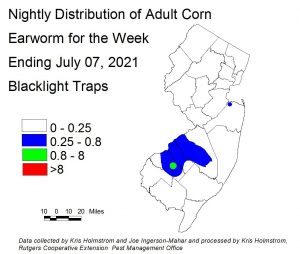 Corn earworm (CEW) moths captures from blacklight traps remain low now, as we head into the slow period of the season. Pheromone trap captures are also fairly low, with a few slightly higher numbers. The number of pheromone traps deployed is much lower, resulting in much broader color bands on the map. It is also important to understand that pheromone traps are more sensitive than blacklight traps, and thresholds are adjusted to account for the higher catches typical of this trap type. Silking corn is at some risk of CEW infestation at this time. On the blacklight map (left), green areas represent a 3-4 day silk spray schedule and blue represents a 4-5 day schedule. On the pheromone map, green represents a 4-5 day schedule, and blue represents a 5-6 day schedule. Be sure to access information from this publication in the upcoming weeks to determine how frequently you should treat silking sweet corn to protect it from CEW infestation.
Corn earworm (CEW) moths captures from blacklight traps remain low now, as we head into the slow period of the season. Pheromone trap captures are also fairly low, with a few slightly higher numbers. The number of pheromone traps deployed is much lower, resulting in much broader color bands on the map. It is also important to understand that pheromone traps are more sensitive than blacklight traps, and thresholds are adjusted to account for the higher catches typical of this trap type. Silking corn is at some risk of CEW infestation at this time. On the blacklight map (left), green areas represent a 3-4 day silk spray schedule and blue represents a 4-5 day schedule. On the pheromone map, green represents a 4-5 day schedule, and blue represents a 5-6 day schedule. Be sure to access information from this publication in the upcoming weeks to determine how frequently you should treat silking sweet corn to protect it from CEW infestation.
The highest nightly blacklight trap catches of CEW for the week ending 07/07/21 are as follows:
| Cinnaminson 1 | Folsom 1 | Medford 1 |
| Crosswicks 1 | Georgetown 1 | Springdale 1 |
| Downer 1 | Matawan 1 | Tabernacle 1 |
The highest nightly pheromone trap catches of CEW for the week ending 07/07/21 are as follows:
| Tabernacle 21 | East Vineland 8 | South Branch 6 |
| Woodstown 12 | Green Creek 8 | Eldora 5 |
| Beckett 10 | Monroeville 7 | Berlin 4 |
| Pedricktown 10 | Elm 6 | Crosswicks 3 |
Silking Spray Schedules*:
South – 4 days
Central – 4 – 5 days
North – 6 days
*These recommendations are based on regional catches. Adhere to tighter spray schedules if indicated by local trap catches. Synthetic pyrethroids alone should NOT be used for corn earworm (CEW) protection on silking corn, or for fall armyworm (FAW) management at any stage. Control with these materials is very inconsistent. Utilize materials in IRAC groups 5 and 28, or combination products that include IRAC group 28 for best control. See the Sweet Corn section of the 2020-21 Commercial Vegetable Production Guide for selections.
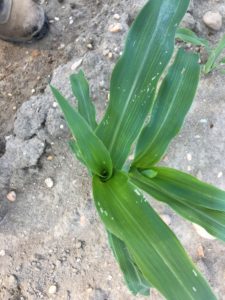
 Fall armyworm (FAW) larval infestations have been disovered in Cape May County this week. As yet, infestation rates are low (6%), but this situation could change with the passing of the tropical storm later in the week. This is the time of the summer when FAW can show up, resulting in significant injury to whorl and even seedling stage corn. Injury from newly hatched larvae shows up as “window panes” or areas where leaf tissue has been eaten down the the lower epidermis (see photo at far left). This injury leads down into the whorl. As larvae gain size, they begin to consume leaf tissue in its’ entirety, creating ragged holes and lots of droppings (see photo at near left). FAW can be tough to manage because it is resistant to synthetic pyrethroid insecticides (IRAC 3A) and because larvae are often covered by their own droppings, making contact with the insecticide more difficult. Treat when 12% or more plants exhibit FAW injury alone, or in combination with ECB injury. As a rule, insecticides that are most effective on CEW will also adequately control FAW.
Fall armyworm (FAW) larval infestations have been disovered in Cape May County this week. As yet, infestation rates are low (6%), but this situation could change with the passing of the tropical storm later in the week. This is the time of the summer when FAW can show up, resulting in significant injury to whorl and even seedling stage corn. Injury from newly hatched larvae shows up as “window panes” or areas where leaf tissue has been eaten down the the lower epidermis (see photo at far left). This injury leads down into the whorl. As larvae gain size, they begin to consume leaf tissue in its’ entirety, creating ragged holes and lots of droppings (see photo at near left). FAW can be tough to manage because it is resistant to synthetic pyrethroid insecticides (IRAC 3A) and because larvae are often covered by their own droppings, making contact with the insecticide more difficult. Treat when 12% or more plants exhibit FAW injury alone, or in combination with ECB injury. As a rule, insecticides that are most effective on CEW will also adequately control FAW.
Tomatoes
As we move into July, brown stink bug injury will likely increase. These true bugs (see photo of Euschistus sp. nymph below at left), move into irrigated tomato fields as forage in the surrounding environment dries out. Feeding results in “cloudy spot” (see photo at right below). Increases in stink bug injury are often found by crews picking the fruit. Growers should consider 1-2 insecticide applications to limit fruit injury if this damage is increasing in harvested fruit. If actively scouting fields, insecticides should be considered if stink bug adults, nymphs or new fruit injury is found in 2 or more sample sites in a 10 site sample. Insecticides that are effective on stink bugs include pyrethroids and neonicotinoids, so care should be taken to avoid contact with foraging bees.
Reports of scattered corn earworm (tomato fruitworm) infestations in high tunnels have come in recently. As this pest arrives in greater numbers 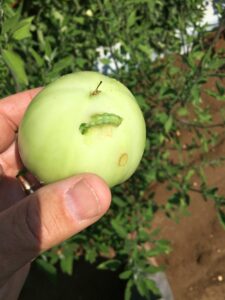 through late summer, it is important to monitor plantings for injury. Female moths lay eggs near flower clusters high on the plant. Larvae hatch and bore into fruit in the upper or outer canopy (see photo at right). If fruitworms or fresh injury are discovered in more than one scouted site, consider an insecticide application in the IRAC 5 or 28 class (see sweet corn section). Repeat applications may be necessary as long as moth counts remain high in any given area.
through late summer, it is important to monitor plantings for injury. Female moths lay eggs near flower clusters high on the plant. Larvae hatch and bore into fruit in the upper or outer canopy (see photo at right). If fruitworms or fresh injury are discovered in more than one scouted site, consider an insecticide application in the IRAC 5 or 28 class (see sweet corn section). Repeat applications may be necessary as long as moth counts remain high in any given area.
Peppers
Pepper weevil – We have still captured no weevils in pheromone traps, and we are not aware of any fields having infestations. A new fact sheet is now available for anyone interested in monitoring for pepper weevils on their own: FS1330: Monitoring and Management of Pepper Weevil in New Jersey (Rutgers NJAES).
Pumpkins and Winter Squash
One cucumber variety in the cucurbit downy mildew (CDM) sentinel plot at Snyder Farm in Hunterdon County showed signs of infection on 07/07/21. All other crops showed no signs of infection. Crops included pumpkins, kabocha, butternut squash, acorn squash, muskmelons and watermelons. Note however, that Dr. Andy Wyenandt has reported CDM on cucumbers (6/16/21) and cantaloupes (6/21/21) in Salem County NJ. Recent showers favored CDM, and this may worsen with the tropical storm forecast to visit NJ overnight Thursday into Friday. For regional information on this important disease, see the Cucurbit Downy Mildew Forecast webpage: http://cdm.ipmpipe.org/. It is advisable that all growers treat preventively for CDM on cucumbers and muskmelons. As yet, there have been no reports in the region of CDM affecting any other cucurbit crops. This is important, as pumpkins and winter squash are now active crops in the region.
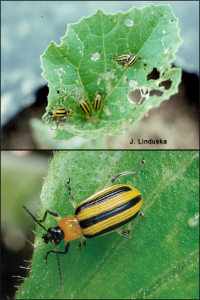 With pumpkin and related crop fields now emerging, it is important to remember that the initial insect threat will be from striped cucumber beetles (photo at left by J. Linduska). Most seeds now come with a pre-applied insecticide to limit injury from this pest. However, growers should be alert to the possibility that untreated seeds may be fed upon heavily by cucumber beetles, resulting in bacterial wilt in a few weeks, or outright death of seedlings from excessive feeding. Scout 5 plants each in 10 random locations. If beetles are found to be feeding at more than two sites, consider an insecticide application to limit damage. See the Pumpkin and Winter Squash section of the 2020-21 Commercial Vegetable Production Guide for labeled insecticides. It is unlikely that this situation will occur if seeds were pre-treated.
With pumpkin and related crop fields now emerging, it is important to remember that the initial insect threat will be from striped cucumber beetles (photo at left by J. Linduska). Most seeds now come with a pre-applied insecticide to limit injury from this pest. However, growers should be alert to the possibility that untreated seeds may be fed upon heavily by cucumber beetles, resulting in bacterial wilt in a few weeks, or outright death of seedlings from excessive feeding. Scout 5 plants each in 10 random locations. If beetles are found to be feeding at more than two sites, consider an insecticide application to limit damage. See the Pumpkin and Winter Squash section of the 2020-21 Commercial Vegetable Production Guide for labeled insecticides. It is unlikely that this situation will occur if seeds were pre-treated.
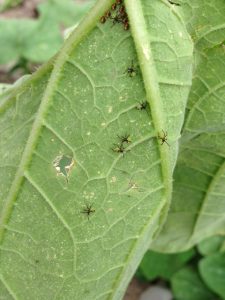
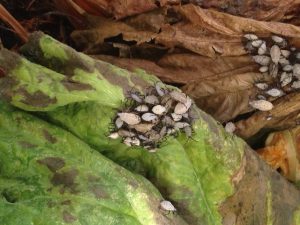 Squash bugs are also appearing in pumpkin fields at this time. Plants that are beyond the 4 true leaf stage are at minimal risk from feeding by squash bugs, and treatment is rarely necessary. Nymphs hatch from copper colored egg masses, and change form dramatically as they go through several molts. Starting as clusters of small greenish nymphs (left), they ultimately become elongated and light gray in color (right).
Squash bugs are also appearing in pumpkin fields at this time. Plants that are beyond the 4 true leaf stage are at minimal risk from feeding by squash bugs, and treatment is rarely necessary. Nymphs hatch from copper colored egg masses, and change form dramatically as they go through several molts. Starting as clusters of small greenish nymphs (left), they ultimately become elongated and light gray in color (right).
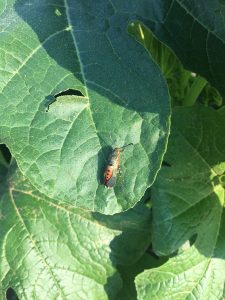 Growers with giant pumpkins, or small plantings should be aware that this is the time when squash vine borer moths are active. This moth resembles a wasp (photo at left), and is typically active early in the morning and again at dusk. Females lay eggs at the base of plants, just above the soil line. The emerging caterpillars bore into the main stem and can cause plants to wilt and die. Larger stemmed cucurbits, such as giant pumpkins and summer squash are favored hosts, and very small garden plots can be heavily impacted. Insecticides labeled for squash vine borer are primarily pyrethroids (IRAC 3A), and recommendations may be found in the Pumpkin and Winter Squash section of the 2020-21 Vegetable Guide.
Growers with giant pumpkins, or small plantings should be aware that this is the time when squash vine borer moths are active. This moth resembles a wasp (photo at left), and is typically active early in the morning and again at dusk. Females lay eggs at the base of plants, just above the soil line. The emerging caterpillars bore into the main stem and can cause plants to wilt and die. Larger stemmed cucurbits, such as giant pumpkins and summer squash are favored hosts, and very small garden plots can be heavily impacted. Insecticides labeled for squash vine borer are primarily pyrethroids (IRAC 3A), and recommendations may be found in the Pumpkin and Winter Squash section of the 2020-21 Vegetable Guide.
Brown marmorated stink bug (BMSB)
BMSB trap catches remain very low. No map will appear in this addition.

